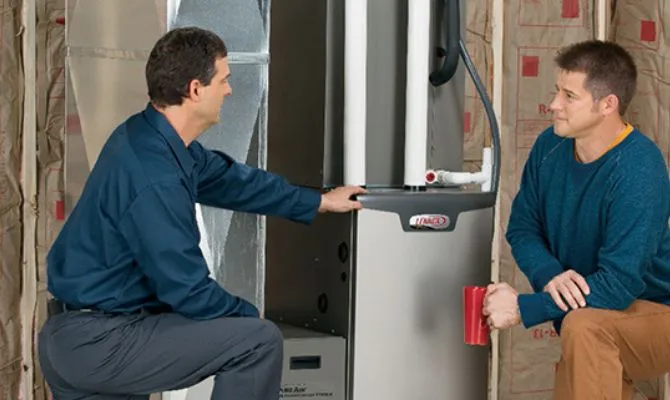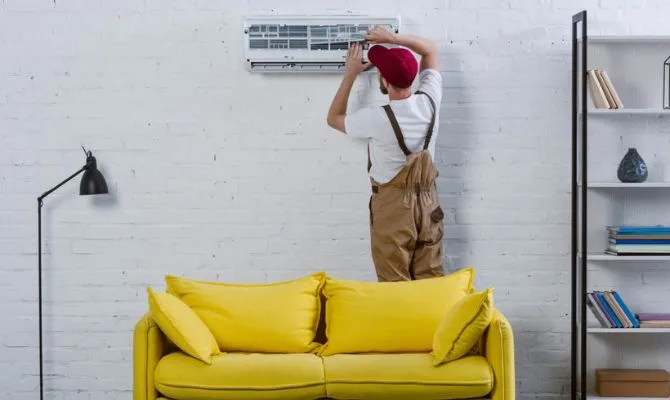Those of us in northern climes know all too well that it’s impossible to live without a furnace in the winter. If you’ve ever had furnace problems during freezing weather, you know that a warm house is far preferable to wrapping yourself in layers of blankets and drinking hot tea to ward off the chill.
A furnace is a mechanical system, and, like any other system composed of multiple parts, things can go wrong. Luckily, they’re treatable, and your HVAC professional will be happy to assist you in fixing anything that is a technical challenge. That’s their calling. First, however, you can try to narrow down the problem by learning a bit more about the usual reasons for heating problems.
When winter arrives suddenly, your furnace becomes a crucial appliance in keeping your home warm. To ensure it runs smoothly, it’s important to perform regular maintenance and be aware of potential problems. Familiarize yourself with common furnace repairs and issues, and learn how to spot them, so you can take action quickly if needed.
What are Common Furnace Issues?
As a homeowner or a business owner, you may experience furnace problems at some point. Below are the 11 most common issues:
1. Cleaning Ductwork for Furnace Efficiency
One of the most overlooked but essential furnace repairs is cleaning dirty ductwork. Over time, dust, dirt, and debris can build up in your heating ducts, obstructing the flow of hot air into your home. As a result, your furnace has to work harder to heat the same amount of space, which can lead to higher energy bills, reduced efficiency, and eventually, a complete breakdown.
To detect this issue, it’s crucial to monitor the airflow of your ductwork. You can do this by simply feeling the air that’s coming out of your vents. If you notice a decrease in the amount of hot air, it’s a clear sign that your ductwork needs cleaning. In some cases, you might also be able to see visible signs of dust or debris buildup in the ducts.
To avoid future problems and ensure your furnace runs efficiently, it’s advisable to establish a regular maintenance schedule with a trustworthy HVAC technician. They will be able to clean your ductwork and the rest of your HVAC system, ensuring that everything is in good working order.
Regular cleaning will also help extend the lifespan of your furnace and keep it running at peak performance for years to come. A professional HVAC technician can help you determine the best maintenance schedule for your specific needs and make any necessary repairs.
2. Changing Furnace Filters
Your furnace’s filter plays an essential role in maintaining a clean and healthy indoor environment. It traps dirt, dust, allergens, and other airborne particles, preventing them from circulating through your home and clogging your ductwork.
While most homeowners are aware of the importance of furnace filters, many are uncertain about how often they need to be changed. The frequency of filter replacement depends on several factors, including the type of filter and the level of air pollution in your area. As a general rule, most filters need to be replaced every 1-2 months. You can check the instructions on the filter’s packaging for more specific information.
A critical indicator that your filter needs to be replaced is reduced furnace performance. If you notice that your furnace isn’t heating the air as effectively as it used to, or if it seems to be working harder than normal, it could be a sign that your filter is full and needs to be changed. This happens because a clogged filter restricts airflow and makes it harder for your furnace to heat the air efficiently. By regularly changing your filters, you can maintain a healthy indoor environment and keep your furnace running smoothly.
3. Repairing the Furnace Starting System
Every furnace has a system that starts the heating process, which varies depending on the type of furnace. Older furnaces often have a pilot light, while newer models use electrical ignitions.
A failing ignition or pilot light can be a major issue for your furnace. When the ignition or pilot light fails, your furnace may not start heating your home, causing discomfort and inconvenience. In some cases, the problem may be minor and can be fixed by replacing or repairing the ignition or pilot light.
If you notice your furnace isn’t turning on when it should, it’s important to inspect the starting system to determine if it’s the cause of the problem. In older furnaces, you may be able to see the pilot light inside the furnace and assess whether it is working properly. In newer furnaces, the electrical ignition system may require a more thorough inspection.
If you’re not sure what the problem is, or if you’re unable to fix the issue, it’s best to call a professional HVAC technician for assistance. They have the knowledge, skills, and experience to diagnose and repair furnace problems quickly and efficiently, ensuring that your furnace is back up and running as soon as possible. By having a professional perform regular maintenance and repairs, you can help keep your furnace running smoothly and prevent issues from arising in the future.
4. Fixing Blower Components for Furnace Repair
Your furnace is equipped with a blower mechanism, which is responsible for blowing heated air into the ducts and heating your home. If you notice that your furnace is no longer blowing hot air, it could be due to a number of problems that require repair.
Fixing Blower Bearings
One of the components of the blower mechanism that can fail are the ball bearings. Over time, ball bearings can become worn down from normal use or be damaged from incorrect installation.
If you hear a scraping sound coming from your furnace, it is a sign that there may be an issue with the blower bearings. It is important to contact an HVAC repair specialist right away to replace the bearings. Continuing to use your furnace with damaged bearings will only worsen the problem, so it’s best to turn off your furnace to prevent further damage.
Fixing Blower Belt
In addition to the ball bearings, the belt for the blower fan can also become problematic. You’ll know there’s an issue if you hear a high-pitched squeal coming from your furnace. The blower belt can either slip out of place, or it can become worn out over time and break.
If the belt has slipped out of place, a simple fix by an HVAC technician may be all that’s needed. However, if the blower belt has broken, a replacement will be necessary. Either of these problems can make your furnace less efficient and increase your energy bill.
Fixing Damaged Blower Capacitor
The capacitor is the key component that powers the blower motor. It functions like a battery, releasing energy to power the system. If the capacitor becomes damaged, the motor will rely on the circuit board for all of its energy needs, leading to a surge in power and potentially tripping the breaker or causing a short circuit.
A furnace that starts but stops mid-cycle is a common symptom of a damaged blower capacitor. An HVAC professional can inspect the damage and determine if a replacement is needed.
5. The Importance of Replacing Your Furnace’s Heat Exchanger
The heat exchanger is a crucial component of your furnace and it is responsible for providing you with warm and comfortable air during the colder months. This component is made up of a coil of heated tubes that the furnace air is pushed through in order to warm it. This heated air is then pushed into your home to provide warmth and comfort.
However, over time, the heat exchanger can become damaged or develop malfunctions. This is because it is subjected to high levels of heat and pressure, which can cause it to crack or break down over time. That is why it is essential to keep up with regular furnace maintenance to ensure that your heat exchanger stays in good condition.
In the event that the heat exchanger does become damaged, it will most likely need to be replaced. This is a more expensive repair compared to some of the other components, but it is still cheaper than having to replace your entire furnace.
If you notice that air is being let out of your vents but it is not very warm, this could be a sign that the heat exchanger is damaged and needs to be replaced. To avoid this costly repair, it is important to be proactive about furnace maintenance and to address any issues that arise as soon as possible.
6. Fixing the Limit Switch on your Furnace
The limit switch plays an important role in your furnace’s operation and your overall safety. By monitoring the temperature inside the furnace, it ensures that the blower fan turns on and off at the right times. This helps distribute the heated air throughout your home effectively.
Moreover, the limit switch is designed to protect your furnace from potential hazards. If the furnace gets too hot, the limit switch will shut off the burners to prevent fires, serious damage to the furnace, and other potential dangers.
7. Signs of a Malfunctioning Limit Switch on your Furnace
One of the most noticeable signs of a malfunctioning limit switch is if your furnace keeps running continuously when it shouldn’t. This can be a cause for concern because it can leave you vulnerable to dangerous problems.
For instance, if your limit switch fails to turn off the furnace when it overheats, you’re at risk of experiencing serious damage to your furnace and your home. To avoid such problems, it’s important to keep an eye out for the signs of a malfunctioning limit switch and take immediate action if you notice any.
If you suspect that your limit switch is malfunctioning, it’s best to call an HVAC technician to have it repaired or replaced. The technician will diagnose the problem and provide you with a solution that ensures the safe and efficient operation of your furnace.
8. Maintaining the Flame Sensor for Optimal Furnace Performance
The high limit switch in your furnace is equipped with a flame sensor rod that performs the crucial task of monitoring the presence of a pilot flame. Once the furnace starts, the flame sensor inspects the flame and if it detects any absence of it, the sensor activates the safety features to shut down the system.
However, over time, the flame sensor may become clogged with soot, debris, and other by-products which can affect its ability to detect the flame and result in the furnace stopping its cycle. To resolve this issue, it is recommended to clean the flame sensor.
To clean the flame sensor, simply unscrew it from the access panel and gently remove any accumulated debris. If the cleaning process appears to be too complex, don’t hesitate to reach out to our HVAC professionals. Our technician will not only clean the flame sensor but also determine if a replacement is necessary to restore proper functioning of the furnace.
9. Diagnosing and Repairing Thermostat Issues for Ideal Furnace Performance
In some instances, when you experience issues with your furnace, the root cause might not lie within the furnace itself, but rather with the thermostat. The thermostat is responsible for monitoring the temperature within your home and instructing the furnace to start heating cycles accordingly. However, if the thermostat is malfunctioning, it could inaccurately pick up the temperature, resulting in the furnace producing unnecessary heat or failing to produce heat when it’s required.
There could be various reasons why the thermostat is not functioning as intended. For example, the electrical system could be having issues that affect the messages being sent from the thermostat to the furnace. In such a case, an HVAC technician would be able to diagnose the problem and determine if it’s a software or hardware issue. The technician will then either repair the existing thermostat or replace it with a functional one to resolve the issue.
10. Tripped Circuit Breaker in Your Furnace: Investigating the Causes
It is not uncommon for a furnace to cause a circuit breaker to trip due to a temporary power surge. If resetting the breaker returns the system to normal operation, there is likely no cause for concern. However, if the breaker continues to trip, it is an issue that needs to be addressed.
It is possible that the furnace is sharing a circuit with another heavy electrical appliance, which could be contributing to the tripping of the breaker. Additionally, there could be ground faults within the electrical circuitry causing an excessive influx of energy.
Regardless of the cause, it is recommended that you seek professional electrical maintenance and repair services. As a temporary solution, you can try operating the furnace on an isolated circuit or separating its circuit board.
11. Your Furnace’s Unpleasant Noises: Uncovering the Mystery
If you’re hearing a series of unpleasant noises coming from your furnace, it’s time to call in the experts. These noises can range from a clunking sound to a thumping noise to a squeaking sound and more. A squeaking noise often indicates a problem with the blower belt, while a scraping noise could signal damage to the blower bearings.
Furnaces are complex machines with many moving parts, and any of these parts can break or become loose at any time. In these cases, the only way to accurately diagnose the problem is for a specialized technician to take a look. To ensure your safety and prevent further damage, it’s best to turn off your furnace until the technician arrives.
So, don’t let those unpleasant furnace noises get you down – call in the experts and get back to a warm and cozy home!
12. Gas Leaks and Odors from Furnace: A Serious Concern
It’s important to be aware of the signs of gas leaks or odors from your furnace. In some cases, you may notice a slight burning smell when you first turn on your furnace at the beginning of the heating season. This is because dust and debris have accumulated in the system over time and are burning off as the furnace heats up. While this may be normal, it’s important to note that the smell should only occur once or twice and should disperse within an hour.
However, if you detect any other unpleasant odors coming from your furnace, it’s crucial to take immediate action. A moldy or musty smell could indicate the growth of allergens and debris in the system, while a metallic smell or the presence of gas is a serious concern.
If you sense gas, it’s important to turn off the gas valve and evacuate the house if possible. Call for immediate furnace repair services to ensure the safety of your home and loved ones. Don’t take any chances with gas leaks or odors – get professional help as soon as possible.
13. The Impact of a Blocked Air Vent on Your Furnace and How to Clear the Air
A blocked air vent can have negative consequences on the functioning of your heating system. If you have a bookshelf standing in front of the air vent in your office and you can hear the air flow turn on, but don’t feel any air coming out, it may be that the air register or vent is either blocked or closed. This can cause the furnace to work harder than necessary to heat the space, leading to increased energy consumption and possibly even overheating.
To prevent these issues and maintain the optimal performance of your heating system, it’s important to clear any obstructions from the air vent. This can help improve air flow and ensure that your space is properly heated without putting undue strain on the furnace. Whether you move the bookshelf or clear any debris blocking the vent, taking these steps can help you “clear the air” and keep your heating system running smoothly.
14. Preventing Clogged Drain Lines in Boilers and Furnaces
Clogged drain lines can be a major issue for boilers and high-efficiency furnaces, as they can impede the proper removal of condensation. This can lead to reduced efficiency and potentially even damage to the system. To avoid these problems, it’s important to regularly inspect the drain lines and hoses for any signs of mold or sediment buildup.
If these materials are allowed to accumulate, they can cause the drain lines to become clogged, making it difficult for the condensation to be effectively removed. This can not only reduce the efficiency of your furnace or boiler, but it can also put stress on the system and potentially cause damage.
Fortunately, this problem can often be prevented or remedied through regular maintenance. By flushing the drain lines, you can remove any buildup and keep them clear, helping to ensure that your furnace or boiler operates at peak efficiency. Whether you do this on your own or seek professional assistance, taking these steps can help you get more efficiency from your heating system and avoid costly repairs.
Troubleshooting Your Furnace: Conclusion for DIYers
Trying to diagnose a problem with your furnace can be a challenge, even if you have a good understanding of common furnace issues. That’s because each component in a furnace system plays an important role, and other factors like temperature, cleanliness, and energy supply can also be responsible for any problems. Pinpointing the exact cause can be a tough task.
However, before calling in a professional for furnace repair, you can do some troubleshooting on your own. This will help you eliminate common furnace problems that don’t necessarily require extensive servicing. By doing a bit of investigation on your own, you may be able to save yourself time and money on repairs.



